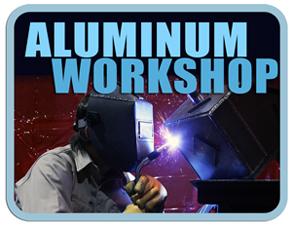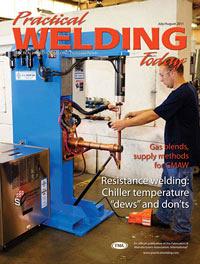President
- FMA
- The Fabricator
- FABTECH
- Canadian Metalworking
Categories
- Additive Manufacturing
- Aluminum Welding
- Arc Welding
- Assembly and Joining
- Automation and Robotics
- Bending and Forming
- Consumables
- Cutting and Weld Prep
- Electric Vehicles
- En Español
- Finishing
- Hydroforming
- Laser Cutting
- Laser Welding
- Machining
- Manufacturing Software
- Materials Handling
- Metals/Materials
- Oxyfuel Cutting
- Plasma Cutting
- Power Tools
- Punching and Other Holemaking
- Roll Forming
- Safety
- Sawing
- Shearing
- Shop Management
- Testing and Measuring
- Tube and Pipe Fabrication
- Tube and Pipe Production
- Waterjet Cutting
Industry Directory
Webcasts
Podcasts
FAB 40
Advertise
Subscribe
Account Login
Search
Aluminum Workshop: Arc blow in aluminum welding
- By Frank Armao
- Updated August 8, 2023
- November 25, 2014
- Article
- Aluminum Welding
Q: I’m welding aluminum plate and extrusions of various alloys using both GTAW and GMAW. Sometimes I encounter what seems to be arc blow while welding, mostly with GMAW. But since aluminum isn’t magnetic, arc blow shouldn’t be possible. Is it something else? If so, what?
A: This is a common misconception. While it is much more common to encounter arc blow while welding steel, it isn’t uncommon to see it while welding aluminum. If the aluminum isn’t magnetic, how does this happen?
What Causes Arc Blow?
Arc blow occurs when a magnetic field interacts with flowing weld current, which causes the arc to deflect. During steel welding, the steel itself can be made magnetic when it comes in contact with magnetic clamps and high magnetic fields. Welding current causes another magnetic field, and any current-carrying conductor is surrounded by a magnetic field. In this case, the current being carried through the arc causes a local magnetic field.
We still have the magnetic field caused by the welding current when welding aluminum. But since aluminum isn’t magnetic, what causes the arc to deflect? The answer often is that the welding fixture, which is usually made from steel, has become magnetized over time. The local fields the welding arc sets up can cause this. This magnetic field interacts with the welding current and its associated field, which causes arc blow.
To put it into perspective, the naturally occurring magnetic field of the Earth is about 0.5 gauss. A magnetic field of 20 gauss in the vicinity is enough to disturb the welding arc. By the time it gets to about 50 gauss, there is so much arc blow that welding is virtually impossible. On a number of occasions I have seen fixtures that had become so magnetized that the magnetic field at the weld preparation was 150 gauss.
Can you remove the magnetic field from the fixture? Maybe. Some companies specialize in degaussing (demagnetizing). However, this might not be practical for large fixtures, so you may need to degauss locally the heavily magnetized areas instead. One tool that is worth having is a hand-held gaussmeter. These are relatively cheap ($100 or so) and will tell you immediately if you are having arc blow problems caused by high magnetization.
About the Author

Frank Armao
Aluminum Consulting Inc.
440-479-0239
About the Publication
Related Companies
subscribe now

The Welder, formerly known as Practical Welding Today, is a showcase of the real people who make the products we use and work with every day. This magazine has served the welding community in North America well for more than 20 years.
start your free subscription- Stay connected from anywhere

Easily access valuable industry resources now with full access to the digital edition of The Fabricator.

Easily access valuable industry resources now with full access to the digital edition of The Welder.

Easily access valuable industry resources now with full access to the digital edition of The Tube and Pipe Journal.
- Podcasting
- Podcast:
- The Fabricator Podcast
- Published:
- 04/16/2024
- Running Time:
- 63:29
In this episode of The Fabricator Podcast, Caleb Chamberlain, co-founder and CEO of OSH Cut, discusses his company’s...
- Industry Events
16th Annual Safety Conference
- April 30 - May 1, 2024
- Elgin,
Pipe and Tube Conference
- May 21 - 22, 2024
- Omaha, NE
World-Class Roll Forming Workshop
- June 5 - 6, 2024
- Louisville, KY
Advanced Laser Application Workshop
- June 25 - 27, 2024
- Novi, MI
































